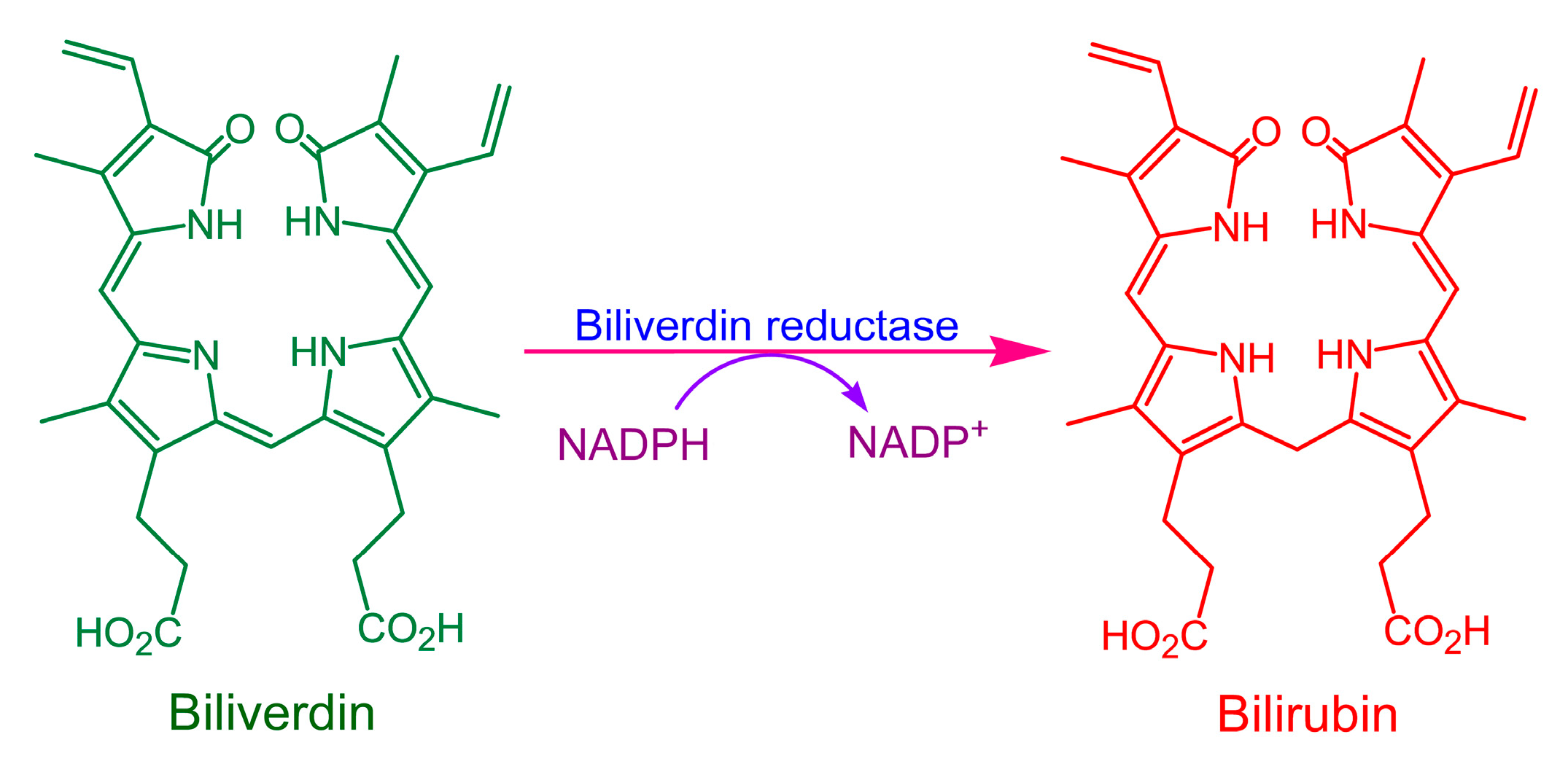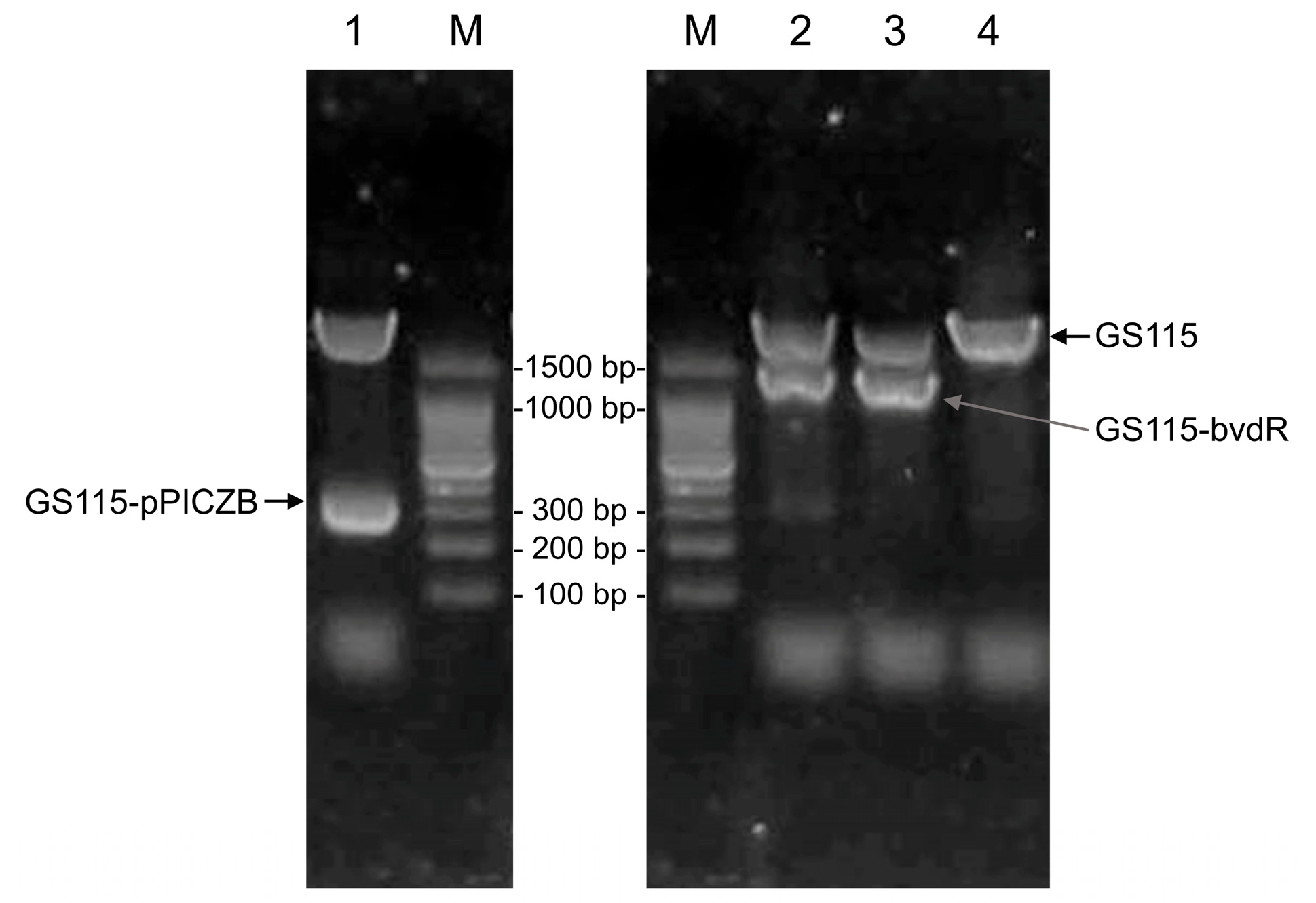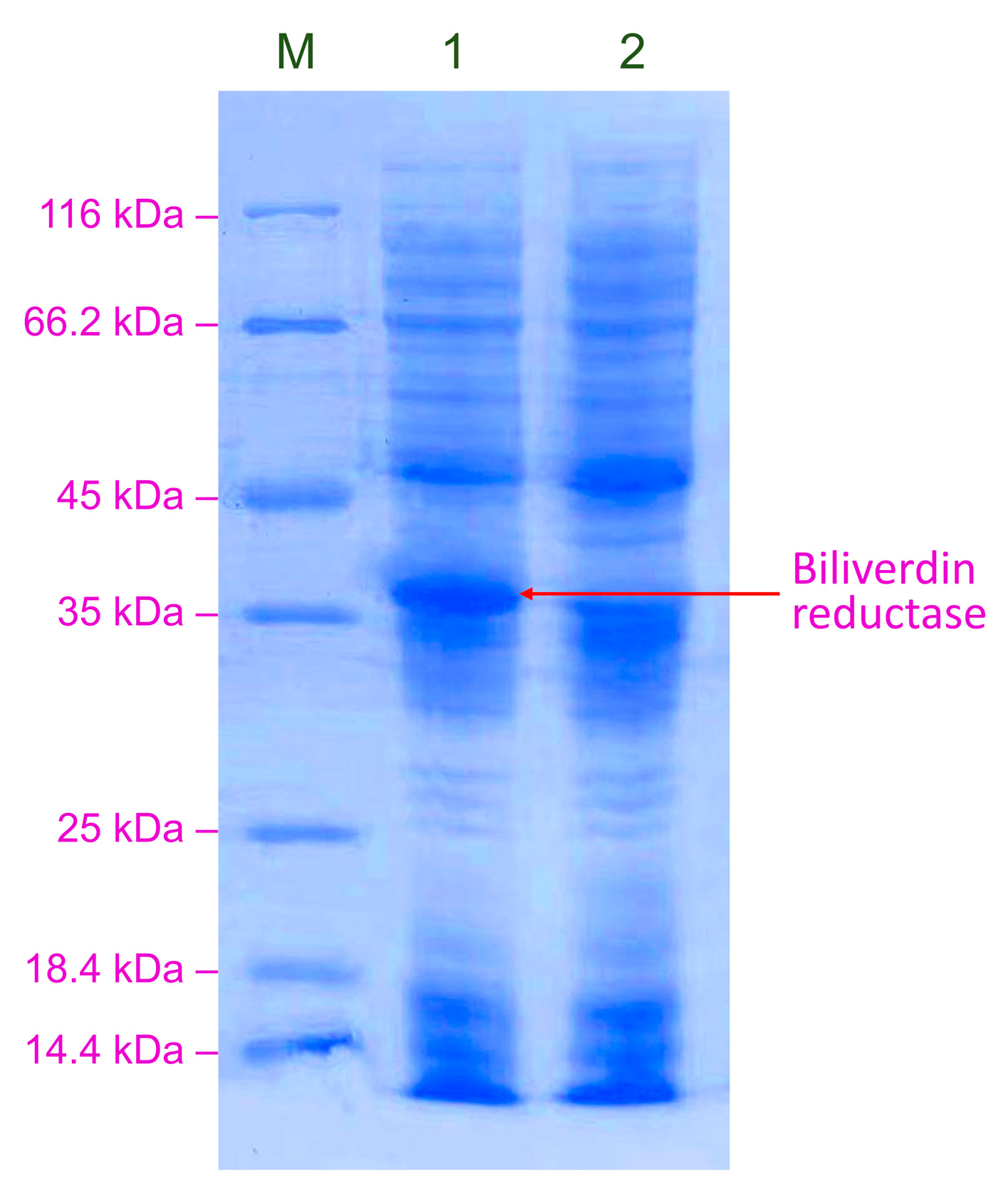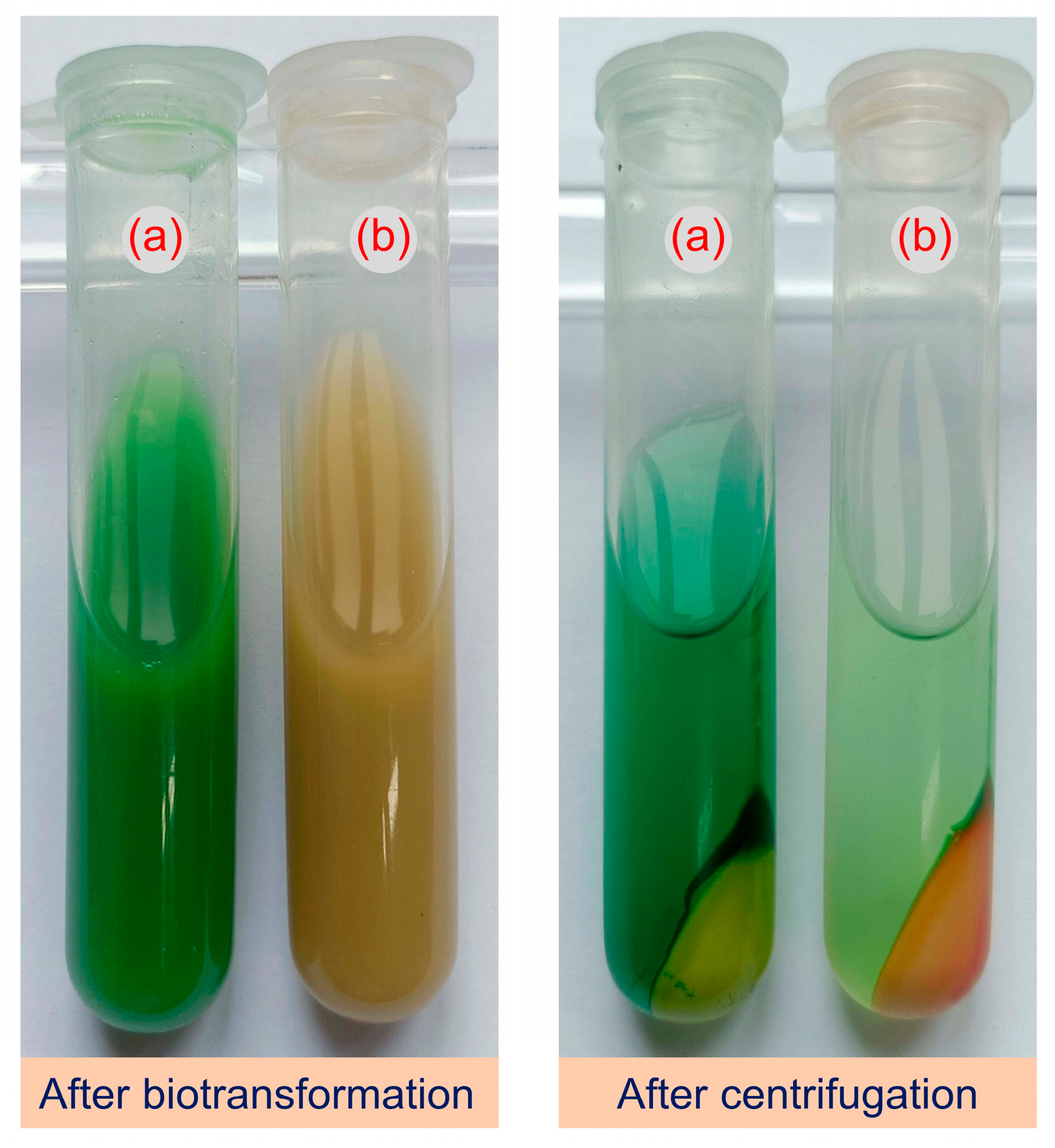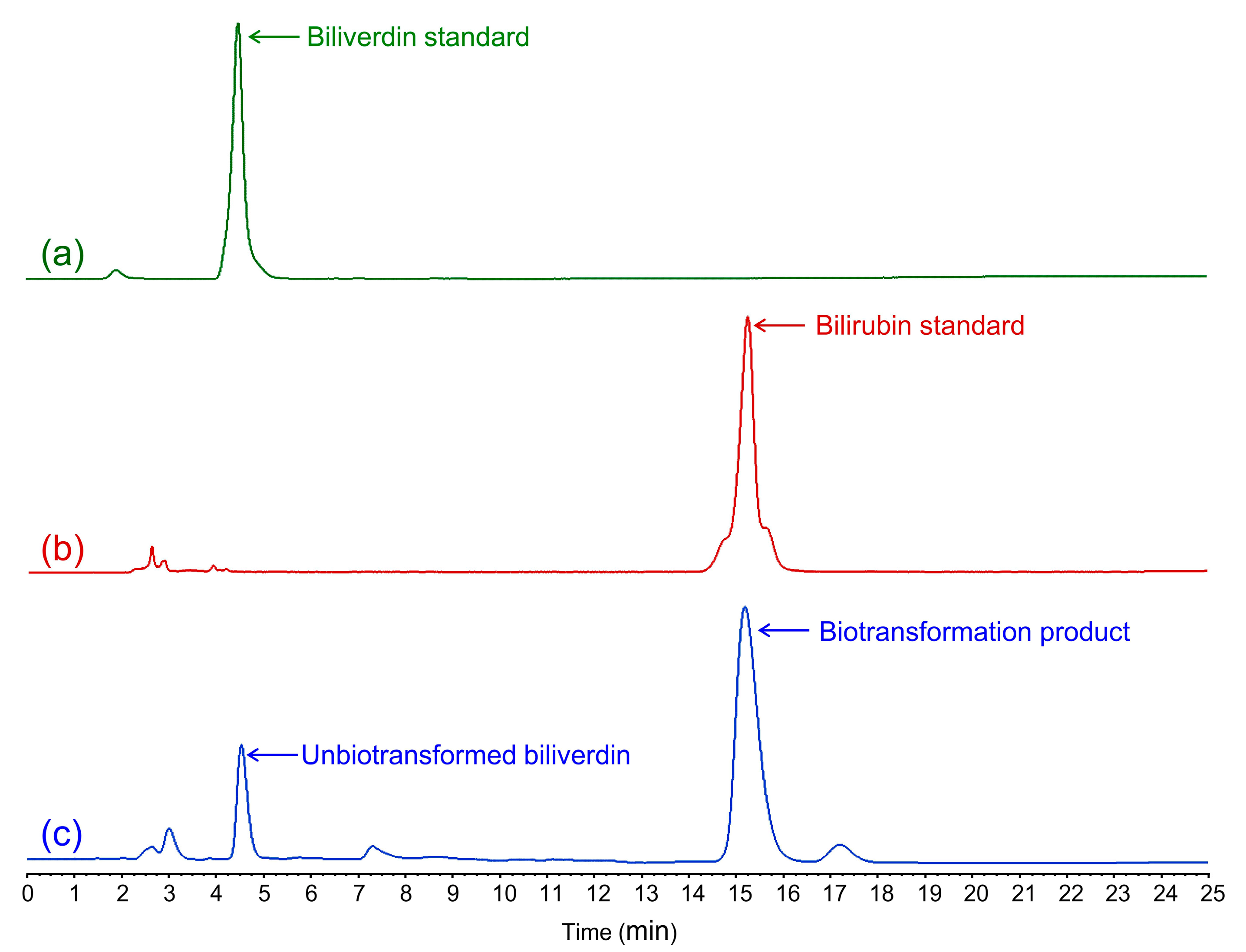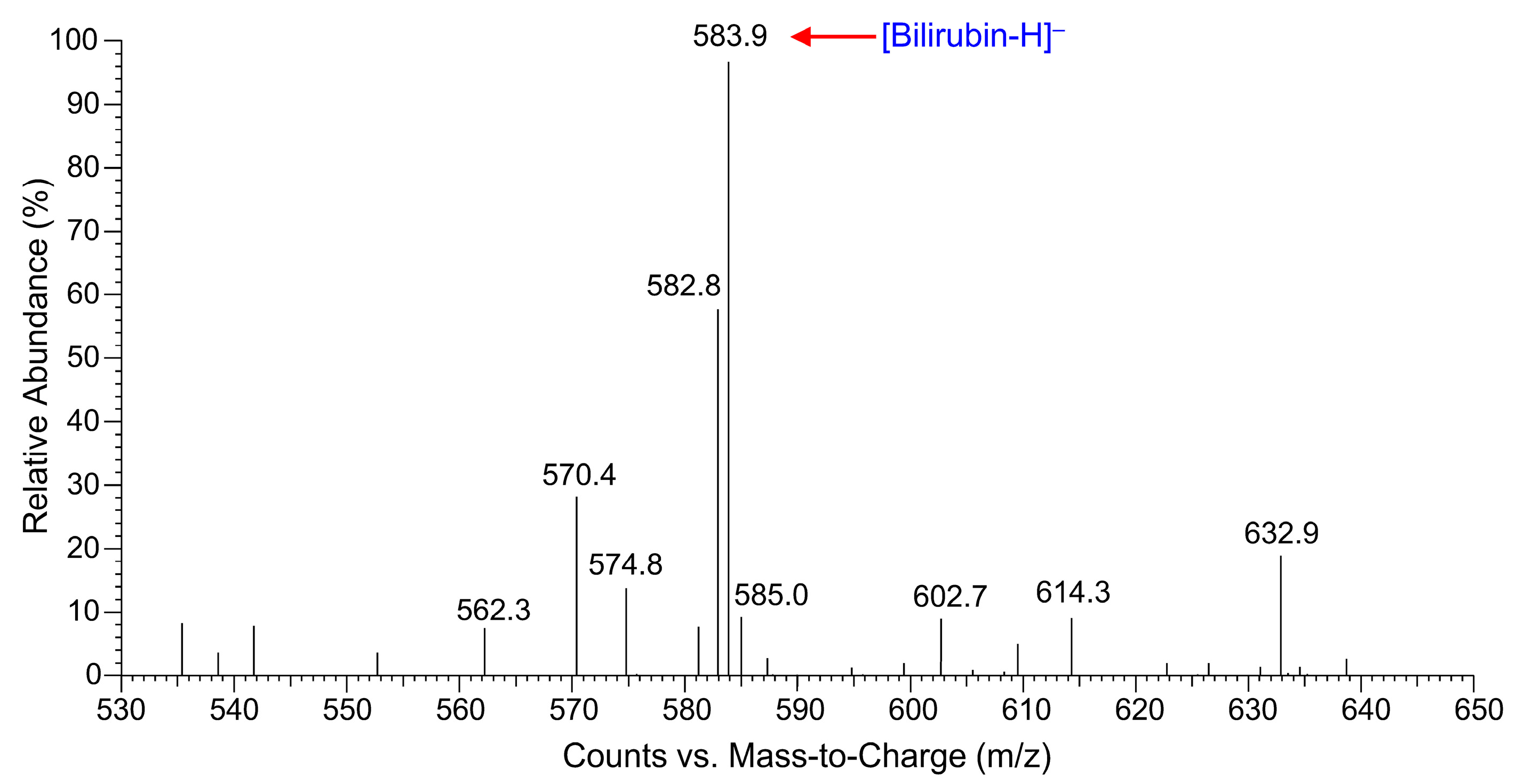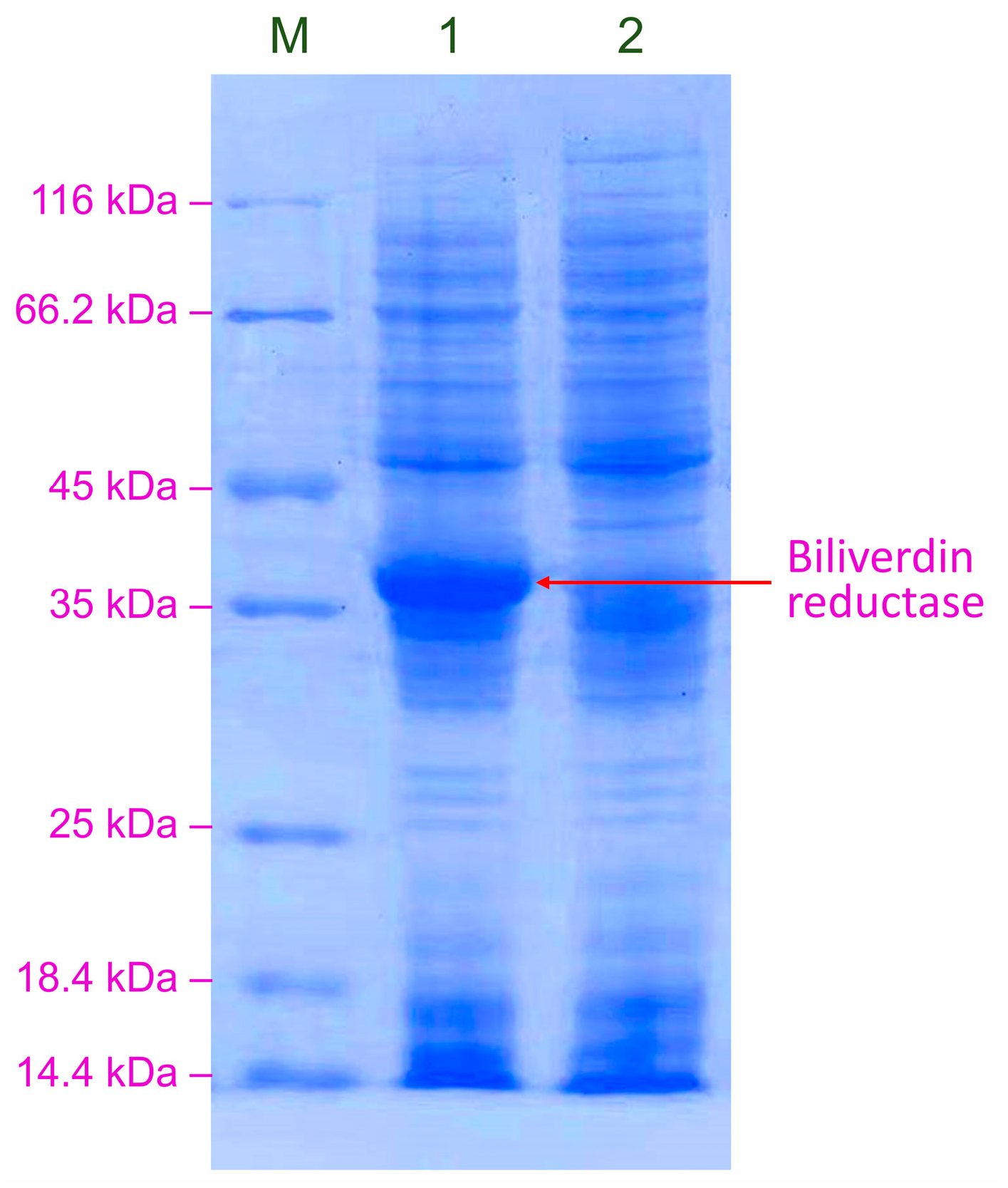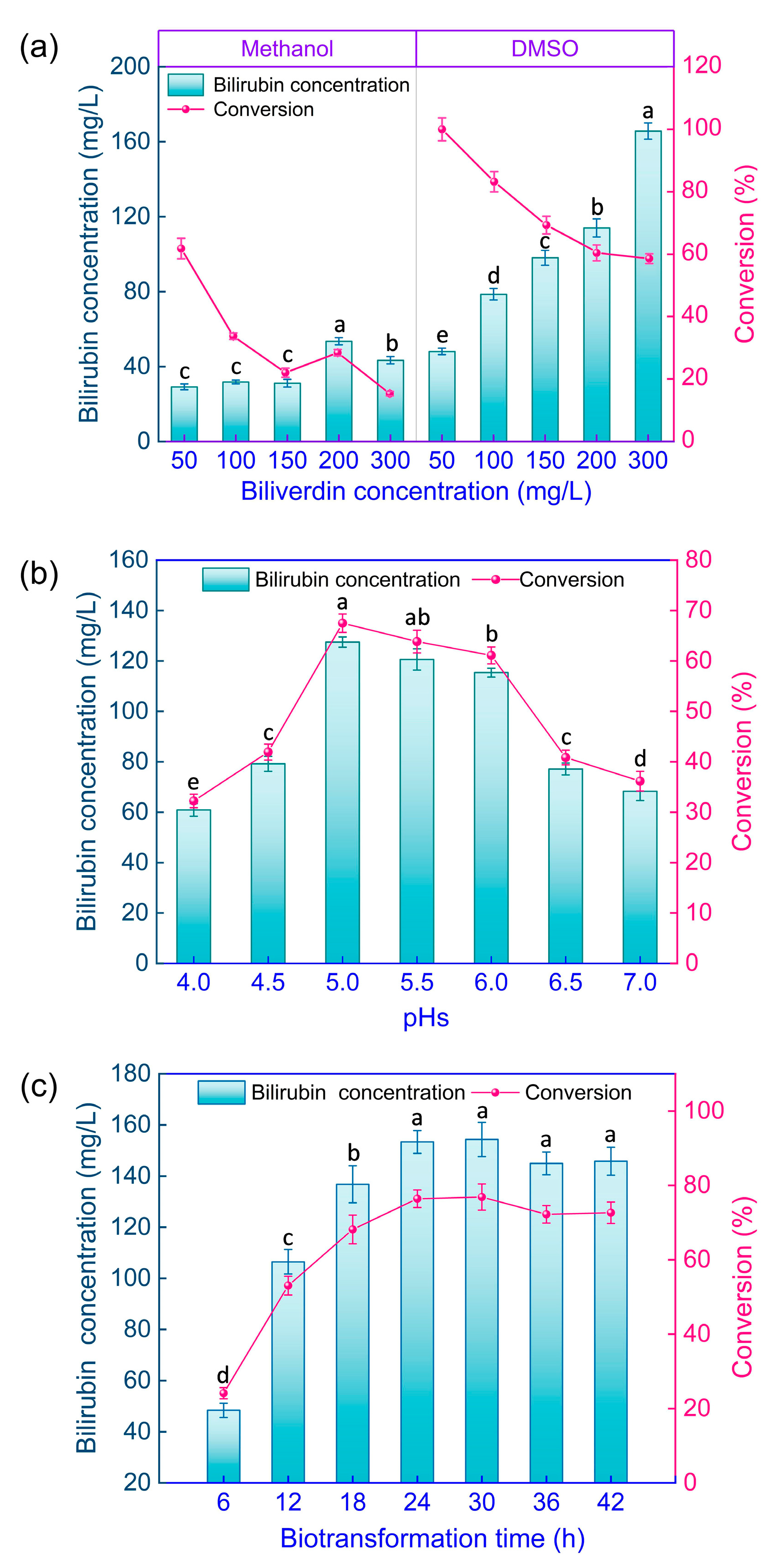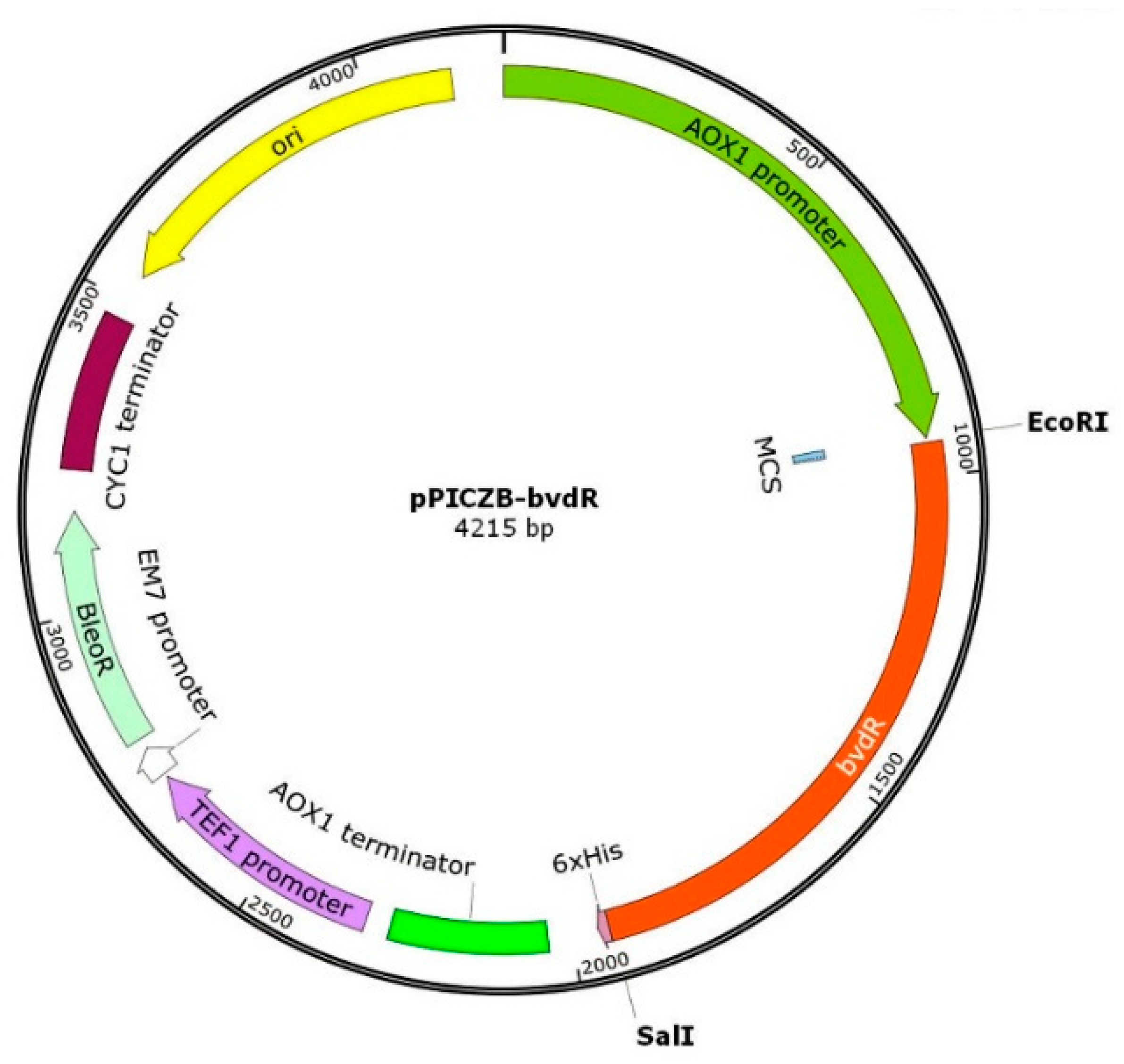1. Introduction
Bilirubin is an important mammalian metabolic product, mainly derived from the breakdown of hemoglobin in aging red blood cells. As red blood cells age, their membranes rupture and hemoglobin is engulfed and digested by macrophages, releasing heme. The porphyrin ring of heme is cleaved to form biliverdin IXα by heme oxygenase (HO, EC 1.14.99.3), which exists in multiple isoforms, including the well-characterized HO-1 and HO-2, as well as the more controversial HO-3, whose functional significance remains under investigation [
1,
2]. Among these, HO-1 is the predominant isoform. The term “biliverdin” typically refers specifically to this isomer. Biliverdin is subsequently reduced by biliverdin reductase (BVR, EC 1.3.1.24) to produce bilirubin [
3]. The transformation of biliverdin into bilirubin by BVR is illustrated in
Figure 1.
Bilirubin was, until recently, considered a useless metabolic waste product, or even harmful to the human nervous system. If blood bilirubin concentrations become excessively high, it can accumulate in the brain, potentially causing diseases such as schizophrenia [
4]; unconjugated bilirubin can also cause encephalopathy and kernicterus [
5]. However, recent research has greatly improved our understanding of the beneficial effects of bilirubin on human health; bilirubin is a potent lipid-soluble antioxidant, capable of neutralizing various reactive oxygen species (ROS) [
6]. When bilirubin levels in serum are normal or slightly elevated, it exerts several important physiological effects, including antioxidant [
7], anti-inflammatory [
8,
9], immune regulatory [
10], antiviral [
11] and antiproliferative activities [
12], so it is now regarded as the essential “yellow hormone” [
13].
Bilirubin is a major component of
Calculus bovis (bovine gallstones), with its content ranging from 50.4% to 56.8% [
14].
C. bovis, also known as ox bezoar or
Bezoar bovis, and
Niuhuang in Chinese, is an important component of nearly one hundred traditional Chinese medicines documented in the 2020 edition of the Chinese Pharmacopoeia, including
Angong Niuhuang Wan,
Niuhuang Jiedu Wan,
Niuhuang Shangqing Pian, and
Niuhuang Qianjin San [
15]. The Chinese Pharmacopoeia stipulates that the bilirubin content of natural
C. bovis should be at least 25.0%.
C. bovis typically occurs only in the gallbladders of aged and unhealthy oxen, but the mechanization of modern agriculture has led to a decline in the population of farmed oxen, resulting in a scarcity of natural
C. bovis resources. Two alternatives have been developed as substitutes for natural
C. bovis,
Calculus bovis sativus (cultured in vitro) and
Calculus bovis artifactus (artificially prepared), with bilirubin being the key component in both preparations. The bilirubin content of
Calculus bovis sativus must be at least 35%, according to the Chinese Pharmacopoeia [
15].
Currently, bilirubin is produced industrially by extraction from pig bile, but the bilirubin content of pig bile is relatively low, at approximately 0.06% (w/w). The shortage of raw materials and low extraction yields have caused ongoing supply shortages for the Chinese bilirubin market, causing the price to soar as high as RMB 60,000 (~USD 8500) per kilogram. Therefore, the development of cost-effective, alternative methods for bilirubin production could provide significant economic benefits.
The chemical synthesis of bilirubin has been extensively studied, but this method is not only low-yielding but also produces a product consisting of a mixture of four bilirubin isomers: IXα, IXβ, IXγ, and IXδ. An effective method for separating these isomers is not currently available, which has rendered the application of chemical synthesis for industrial bilirubin production both impractical and uneconomic. However, biosynthesis has emerged as a very effective production method for the pharmaceutical industry [
16], suggesting that the biosynthetic production of bilirubin could be a viable alternative to current bilirubin production methods.
Heme is a natural precursor to bilirubin, which is produced in large quantities from animal blood, such as that of pigs and cows, and is available at a relatively low market price. Enzymic biocatalysis is a promising method for producing bilirubin from heme, but this approach faces several challenges. Recombinant
Escherichia coli, which expresses HO-1 and BVR, is not a practical whole-cell biocatalyst; heme cannot easily enter the cells to interact with the enzymes because the
E. coli cell membrane lacks heme transporters [
17,
18], resulting in low biocatalytic efficiency. Using free HO-1 and BVR for the biotransformation of heme into bilirubin is severely hampered by the low solubility of bilirubin in water and the requirement for NADPH as a cofactor for BVR, which must be added in large quantities at considerable costs or regenerated enzymically, also resulting in low biocatalytic efficiency.
Biliverdin, the immediate precursor of bilirubin, is available from natural sources, such as birds’ eggshells and the bile of birds [
19,
20] and fish [
21]. Although the biliverdin concentration is relatively low (e.g., ~0.04% in chicken bile), this abundant natural resource has not yet been fully utilized. Biliverdin can serve as a substrate for bilirubin production, but the cost of extracting biliverdin from animal tissues may be high, making bilirubin produced from biliverdin less cost-competitive than that extracted from pig bile. Therefore, this method is unlikely to replace the extraction of bilirubin from pig bile. However, it could serve as an alternative method for producing bilirubin and increase overall bilirubin production, thereby reducing its market price. Biliverdin can be converted into bilirubin by chemical or biological processes, but the biological method has advantages, including high efficiency, excellent selectivity, mild reaction conditions, and much greater environmental sustainability.
Our previous study reported the biocatalytic production of bilirubin from biliverdin using recombinant
E. coli expressing BVR; a starting biliverdin concentration of 450 mg/L resulted in a conversion of 72.3%, with a final bilirubin content of 20.8 mg/g in the dried cells [
22]. However, the bilirubin yield from this method is not high enough for it to be a viable industrial process. The use of yeast cells appears to offer advantages, such as larger biomass and greater availability of endogenously produced NADPH compared to
E. coli cells, suggesting that using BVR-expressing yeast cells to transform biliverdin into bilirubin would be more efficient. In this study, a recombinant
Komagataella phaffii (previously known as
Pichia pastoris) strain expressing intracellularly active BVR was constructed, which can produce bilirubin through the biotransformation of biliverdin.
3. Materials and Methods
3.1. Strains and Plasmids
The K. phaffii strain GS115 and plasmid pPICZB were obtained from Yinyuan Biotech Co., Ltd. (Hangzhou, China). E. coli DH5α was obtained from Beijing Tsingke Biotech Co., Ltd. (Beijing, China).
3.2. Reagents, Enzymes, and Test Kits
The Rapid Yeast Genomic DNA Isolation Kit, Plasmid DNA Mini-prep Kit, SDS-PAGE Preparation Kit, DNA Gel Extraction Kit, primers of 5′-AOX and 3′-AOX (sequences shown in
Supplementary Data: Table S1), DNA, and protein markers were obtained from Sangon Biotech Co., Ltd. (Shanghai, China). DNA restriction enzymes (
EcoR I,
Sal I., and
Sac I) were obtained from Takara Biomedical Technology Co., Ltd. (Beijing, China). TS GelRed nucleic acid dye and T5 super PCR mix were obtained from Beijing Tsingke Biotech Co., Ltd. (Beijing, China). Standard biliverdin hydrochloride (≥95%) and bilirubin (≥98%) were obtained from Aladdin Reagent Co., Ltd. (Shanghai, China). Biliverdin substrate was prepared from chicken bile in our laboratory, with a purity of 33.7%. Zeocin was obtained from Thermo Fisher Scientific Inc. (Carlsbad, CA, USA), and all other reagents were commercially available at analytical or biological grades.
3.3. Culture Media
The culture media used were as follows: Luria–Bertani medium (LB): 10 g/L peptone, 5 g/L yeast extract, 10 g/L NaCl, and pH 7.0; yeast extract peptone dextrose medium (YPD): 10 g/L yeast extract, 20 g/L peptone, 20 g/L dextrose, and pH 7.2; buffered glycerol-complex medium (BMGY): 20 g/L peptone, 10 g/L yeast extract, and 10 g/L glycerol; yeast nitrogen base (YNB): total volume of 13.4 g/L, with 0.4 mg/L biotin, prepared at pH 5.0, and 0.1 mol/L sodium citrate buffer; buffered methanol-complex medium (BMMY): 20 g/L peptone, 10 g/L yeast extract, 10 mL/L methanol, 13.4 g/L YNB, and 0.4 mg/L biotin, prepared at pH 5.0, and 0.1 mol/L sodium citrate buffer.
3.4. Recombinant Plasmid Constructs
The DNA sequence encoding BvdR (
bvdR, Gene ID: 14615643 (sequence shown in
Supplementary Material: Table S1) from
Synechocystis 6803, retrieved from the NCBI database (
https://www.ncbi.nlm.nih.gov, accessed on 15 April 2022), was optimized using
K. phaffii-preferred codons (GenSmart
TM,
https://www.genscript.com.cn/tools/gensmart-codon-optimization, accessed on 18 April 2022; the sequence is shown in
Supplementary Material: Table S1). The
EcoR I and
Sal I digestion sites were introduced upstream (5′-GAATTC-3′) and downstream (5′-GTCGAC-3′), respectively. The synthesized (by Beijing Qingke Biotech Co., Ltd., Beijing, China)
bvdR sequence and vector pPICZB were digested with
EcoR I and
Sal I, respectively. They were then ligated using the T4 DNA ligase and transformed into
E. coli DH5α-competent cells. The recombinant
E. coli was cultured on LB plates containing zeocin (50 μg/mL). The colonies were then picked to verify the positive transformants by PCR. The recombinant vector pPICZB-bvdR (plasmid map in
Figure 9) was extracted from the positive transformants after being cultured in LB medium containing zeocin (50 μg/mL).
3.5. K. phaffii Transformation
The plasmid pPICZB-bvdR was linearized using the Sac I restriction enzyme. A mixture of pPICZB-bvdR (20 μL) and a GS115-competent cell suspension (80 μL) was transferred into a pre-cooled electroporation cuvette (0.2 cm type). After cooling on ice for 5 min, the cells were subjected to an electric pulse of 4 ms in the “Fungi Pichia” mode using an electroporation device (MicroPulser 1652100, Bio-Rad, Philadelphia, PA, USA). Following electroporation, pre-cooled sorbitol solution (1 mL, 1 mol/L) was immediately added to the cuvette, and the cell suspension was transferred to a 1.5 mL centrifuge tube, revived in a water bath at 30 °C for 2 h, and then plated on YPD agar plates containing 50 mg/L zeocin. The plates were incubated at 30 °C for 48 h. Single colonies on the YPD agar plates were picked and inoculated individually in YPD liquid medium (5 mL, containing 50 mg/L zeocin). The cultures were incubated at 30 °C for 24 h, after which their genomic DNA was extracted. The target genes were amplified by PCR using the 5′-AOX and 3′-AOX primers, and then the PCR products were recovered and sequenced for verification. The recombinant K. phaffii GS115 strain carrying bvdR was designated as GS115-bvdR. A control strain containing the empty vector, GS115-pPICZB, was produced similarly.
3.6. Expression and SDS-PAGE Analysis of BVR Protein
The recombinant GS115-bvdR cell suspension (1 mL), which had been stored in a 20% glycerol solution at −80 °C, was inoculated in BMGY (50 mL) and then cultured at 30 °C and 180 r/min for 16 h until the OD600 reached ~6.0. The culture was then transferred into a 100 mL sterile centrifuge tube and centrifuged at 5000× g for 5 min. The supernatant was discarded, and BMMY (25 mL) was added to resuspend the cells. The suspension was transferred into a 250 mL sterile conical flask and cultured at 30 °C and 200 r/min for 3–5 d to reach an OD600 of 10–12. Methanol was added every 24 h to a final concentration of 1% v/v.
An aliquot (100 μL) of the GS115-bvdR culture was centrifuged at 8500×
g for 5 min. The supernatant was discarded, and the yeast cells were resuspended in 50 μL of sodium citrate buffer (1 mL, pH 6.0, 0.1 mol/L). The cells were lysed using a freeze–thaw method, which involved boiling the cell suspension for 5 min, freezing it in liquid nitrogen for 10 min, and then boiling it again for 5 min. This process was repeated three times. Lysate (16 μL) and 5 × protein loading buffer (4 μL) were mixed, heated in boiling water for 10 min, and analyzed by SDS-PAGE [
23].
3.7. BVR Enzymic Activity Determination
The GS115-bvdR culture (5 mL) was centrifuged at 8500×
g for 5 min, the supernatant was discarded, and sodium citrate buffer (1 mL, pH 6.0, 0.1 mol/L) was added to resuspend the cells. The yeast cells were ultrasonically disrupted and then centrifuged at 8500×
g for 10 min at 4 °C; then the supernatant was used for BVR activity assays, as described previously, with some modifications [
24].
The BVR assay solution consisted of biliverdin (40 μL of a 0.15 mmol/L methanolic solution), sodium citrate buffer at pH 6.0 (100 μL, 0.1 mol/L), BSA solution (40 μL, 10 g/L), NADPH solution (120 μL, 20 mmol/L), and GS115-bvdR cell lysate (700 μL) in a 1.5 mL centrifuge tube, incubated at 30 °C for 30 min. The A450 of the reaction mixture was measured and the bilirubin concentration was calculated using a bilirubin standard curve at 450 nm. BVR activity is expressed as the amount of enzyme (in mL) required to produce 1 μg of bilirubin per minute at 30 °C and pH 6.0.
3.8. Biotransformation of Biliverdin to Bilirubin by Recombinant Yeast Cells
A GS115-bvdR resting culture (25 mL) was centrifuged at 5000× g for 5 min to collect the cells, which were then resuspended in sodium citrate buffer (pH 6.0, 4.0 mL, 0.1 mol/L). Biliverdin solution in methanol or DMSO (1.0 mL) was added to the resting cell suspension and then shaken at 30 °C for an appropriate time.
3.9. Analysis of Bilirubin
The biotransformation mixture was centrifuged at 8500× g for 10 min, the cell pellet was retained, and the cells were washed twice with deionized water and resuspended in methanol/dichloromethane (10 mL, 2:1 v/v). The extraction was performed by ultrasonication at 0 °C and 100 W for 30 min, and then the extract was centrifuged at 8500× g for 5 min, retaining the supernatant. The supernatant was analyzed by high-performance liquid chromatography (HPLC) after being filtered through a 0.22 μm membrane.
Bilirubin was quantified by HPLC using a Phenomenex C18 column (Torrance, CA, USA, 5 µm, 150 mm × 4.6 mm) fitted to a Shimadzu LC-20A System (Shimadzu, Kyoto, Japan). The mobile phase consisted of acetonitrile/water (95:5 v/v) containing 0.1% acetic acid at a flow rate of 1 mL/min. The column temperature was 30 °C and the detection wavelength was 450 nm.
The biotransformation product was confirmed as bilirubin by liquid chromatography–electrospray ionization–mass spectrometry (LC-ESI-MS) using an LCQ Deca XP Plus mass spectrometer (Thermo-Fisher, Waltham, MA, USA). The scanning range was m/z 530–650, the capillary temperature was 300 °C, and the capillary voltage was 4.0 kV.
The conversion of bilirubin from biliverdin was calculated as shown in Equation (1):
where 584.7 Da and 582.6 Da are the molecular weights of bilirubin and biliverdin, respectively.
3.10. Statistical Analysis
All experiments were conducted with three independent replicates, and the results were presented as the mean ± standard deviation (SD). The data were analyzed using analysis of variance (ANOVA). A significant difference was considered to occur at p < 0.05.
